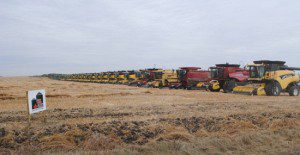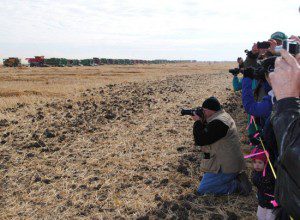
We don’t very often get the chance to witness a world’s record. Oh, in the Toronto area, we used to be able to walk by the world’s tallest freestanding structure, the CN Tower, until they built one taller in Dubai a couple of years ago. I once stood within a metre of the world’s biggest gem, the Hope diamond, at the Smithsonian in Washington, D.C. And I’ve personally witnessed a bunch of The Great One’s goal-scoring feats, some of which are world’s records I guess (the 50 goals in 39 games, for example). But I’ve rarely associated the province of Saskatchewan (where I lived for a while) with any world’s records. Then, this week, I got a note from an old friend, Dennis Fisher, in Saskatoon.
“We watched 249 combines harvest a [half] section of land in seven minutes,” he wrote me. “It was a Guinness World Record.”
Dennis Fisher and I worked together at a Saskatchewan radio station back in the 1970s. And on more than one occasion both he and I travelled through the typical prairie town of Dalmeny, northwest of Saskatoon. But neither of us would ever have considered the place particularly worldly, much less capable of setting a world’s record. But last Saturday Dalmeny did it. Or at least the organizers of a fundraiser for Harvest for Kids did it. They managed to convince international implement dealers, individual family famers and harvest machinery buffs to assemble the largest collection of grain combines ever.
Then, in front of media from all over, a line of combines – about a mile long – simultaneously, side-by-side and in less than 10 minutes cut through a quarter section of wheat. Hundreds witnessed the combine feat, including my friend Fisher.
“A Mennonite lady told us she prayed for good weather,” he wrote. “We were given a perfect day.”
Now Canadians outside the prairie provinces of Manitoba, Saskatchewan and Alberta might not understand the significance of swathing, combining and stowing about 300 acres of grain in that short of time span. But when one actually experiences the annual harvest of prairie grain, such achievements come into clearer focus. It was exactly 40 years ago – the autumn of 1972 – when I participated in a wheat harvest. I was asked to assist a friend bring in his crop. I would drive a hopper truck from this man’s wheat fields – in middle of the grain belt between Regina and Moose Jaw – back to his granaries a few kilometres away.
We started on Friday afternoon about 3 o’clock. We worked well into the night. I recall sitting in the hopper truck under a starry sky, watching two combines, with lights illuminating the ground way off in the distance, make the long circuit around the ripened wheat stand. They paused only long enough to dispense their precious grain cargo into the box of my truck. Then I drove through the darkness to the man’s harvest granaries on the home quarter section. There I set the auger running, slowly tipped the hopper truck box to dispense the grain and watched it shoot out the top of the auger into one of his two-storey-tall, steel granaries.
We worked around-the-clock for nearly three days and filled that man’s half dozen granaries with tonnes of golden wheat kernels. We only stopped twice – once for a few hours sleep and a second time when, finally, on the Sunday afternoon drizzle began to fall. And even as the drizzle grew to raindrops and brought our three-day harvesting operation to a halt, I watched something happen I suspect would only happen on a prairie wheat farm in harvest season.
The farmer who had enlisted me for the weekend began tidying up around the granaries. He raked up all the grain that had spilled over the edges of my auger box and deposited it in the granary. At one point he even knelt down to scoop up the last few handfuls of wheat accidentally left outside the auger box.

“Every kernel’s worth something,” he said. And I knelt down to join him retrieving those last few kernel of wheat from his harvest.
I thought of that farmer, saving each morsel of his 1972 harvest and of the payday it ensured his family that season. And I thought of my friend Dennis Fisher describing Dalmeny’s world’s record of men and machinery harvesting 300 acres of wheat in front of the town and the media. I don’t imagine the Harvest for Kids charity cared as much about the record as it did the money raised. But for me, Dalmeny’s record-breaking moment signified what Fisher called “a prairie spirit event.”
It symbolized people against the elements, a community getting the job done and an agricultural heritage as old as the land itself. The fact it was also a Guinness World Record was a bonus.